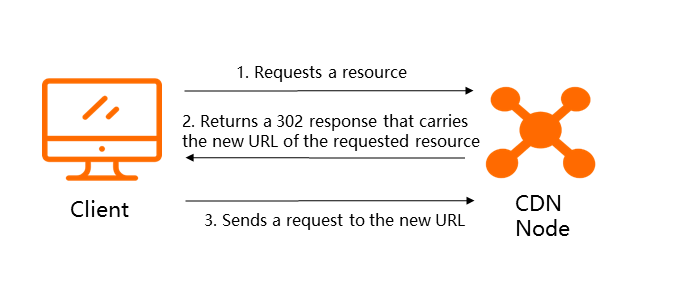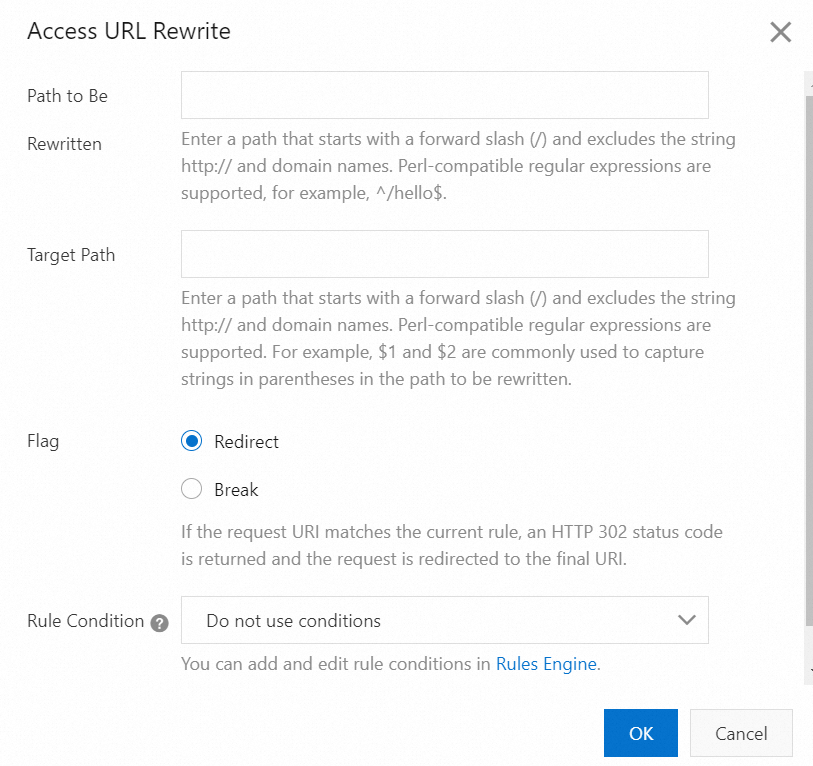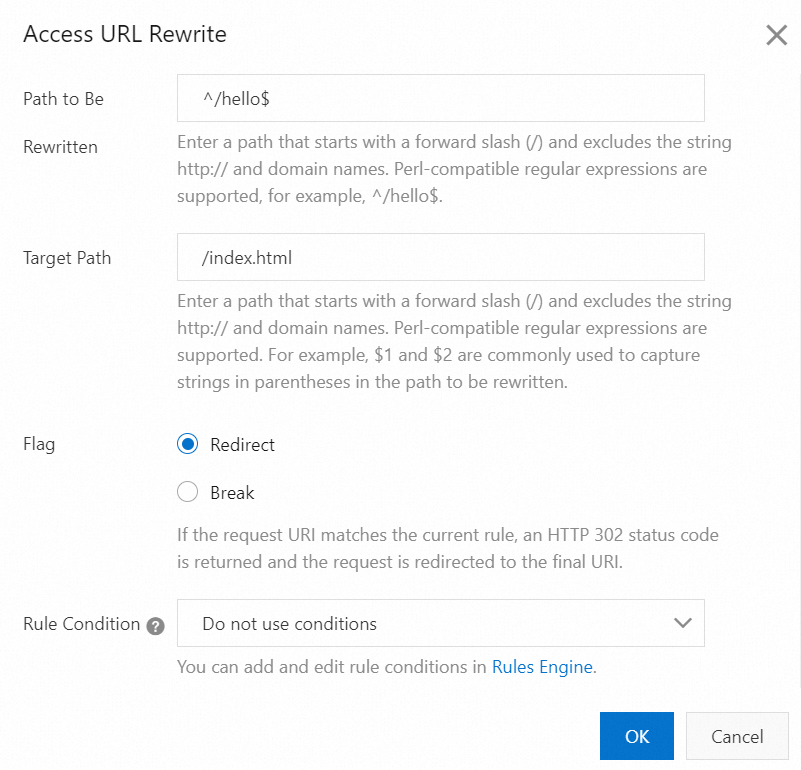If the directory of a resource on the origin server changes, the directory of the resource on points of presence (POPs) also changes. If the request URL to the resource does not change, POPs need to rewrite the request URL and redirect the request to the destination directory. This reduces the number of back-to-origin requests and improves client access performance.
Background information
The HTTP 302 status code, also known as the Found message, indicates that the requested resource has temporarily relocated. After you configure the access URL rewrite feature, POPs add the new URL of the resource to the Location header in the response message of the HTTP status code 302. After the client receives the message, the client sends a request to the new URL.
After you create an access URL rewrite rule, the POPs return the HTTP status code 302 to the client by default if the requested resource has relocated. You can also set the HTTP status code to 303 or 307. To change the HTTP status code, submit a ticket.
HTTP status code | Description | Solution | Scenario |
302 | Found | GET requests remain unchanged. Requests that use other methods may be changed to GET requests. | A web page is temporarily inaccessible due to unknown reasons. In this case, search engines do not update the URL to the web page. |
303 | See Other | GET requests remain unchanged. Requests that use other methods are changed to GET requests. The message body is dropped. | Web pages are redirected after PUT or POST requests are processed to prevent frequent requests that are initiated by a page refresh. |
307 | Temporary Redirect | The request method and message body remain unchanged. | A web page is temporarily inaccessible due to unknown reasons. In this case, search engines do not update the URL to the web page. If the website supports requests that use methods other than GET, the HTTP 307 status code is returned instead of the HTTP 302 status code. |
You can create up to 50 rewrite rules for a domain name. If you create multiple access rewrite rules, the rules are applied in descending order in which they are listed in the Alibaba Cloud CDN console.
Scenarios
A resource on the origin server is moved to a different URL, and the URL of the resource that is cached on Alibaba Cloud CDN POPs is updated. However, a client sends a request to the original URL. In this case, Alibaba Cloud CDN must rewrite the request to redirect the request to the new URL. For example, an image file is moved from the /download/ directory to the /image/ directory.

Procedure
Log on to the Alibaba Cloud CDN console.
In the left-side navigation pane, click Domain Names.
On the Domain Names page, find the domain name that you want to manage and click Manage in the Actions column.
In the left-side navigation tree of the domain name, click Cache.
Click the Access URL Rewrite tab.
Click Create and configure the parameters based on your business requirements.

Parameter
Description
Path to Be Rewritten
Enter a URL that starts with a forward slash (/). The URL cannot contain http:// or domain names. You can use Perl Compatible Regular Expressions (PCRE) to specify the URL. Example: ^/hello$.
Target Path
Enter a URL that starts with a forward slash (/). The URL cannot contain http:// or domain names. Example: /index.html.
Flag
By default, Redirect and Break are supported.
Redirect: If the URL in a request matches a rule, Alibaba Cloud CDN returns the HTTP 302 status code and the request is redirected to the actual URL. The value of the Location header in the response message that is returned by the POP to the client is the actual URL. Parameters in the original URL are not modified. After the current rule is executed, the request is matched against other rules.
Break: If the URL in a request matches a rule, the requested URL is overwritten by the actual URL. Parameters in the original URL are not modified. After the current rule is executed, other rules are skipped.
Empty, enhance-break, and enhance_redirect are also supported. To use these rules, submit a ticket.
Empty: If multiple rules are configured and the URL in a request matches a rule, subsequent rules are matched after the current rule is executed.
enhance_break: enhance_break is similar to Break, but modifies the URL, including parameters.
enhance_redirect: enhance_redirect is similar to Redirect, but modifies the URL, including parameters.
NoteDifferent rules use different rewrite methods, and whether the rewritten URL supports other domain names and other protocols also vary.
Empty, Break, and enhance_break rewrite the URL in a request, but cannot modify the domain name or protocol in the URL. For example, the rules cannot modify the protocol from HTTP to HTTPS.
Redirect and enhance_redirect use 302 redirection to rewrite a URL, and can modify the domain name or protocol in the URL.
302 You can set the Location header in 302 redirection responses to the current domain name or another domain name. This way, the original URL uses the
example.comdomain name, and the rewritten URL uses thealiyundoc.comdomain name.302 The Location header in 302 redirection responses supports different protocols.
Rule Condition
Rule conditions can identify parameters in a request to determine whether a configuration applies to the request.
Do not use conditions
Select the configured rule conditions in Rules Engine. For more information, see Rules engine.
Enable NGINX variable computing
By default, the check box is not selected. If you select this check box, you can use NGINX built-in variables in the target URL. Sample configurations:
Path to be rewritten:
^/test.jpg$Target path:
/test.${arg_type}After you enable NGINX variable calculation, the value of ${nginx_var} is calculated. ${arg_type} indicates the value of the type parameter in the original URL.
NoteTo configure this parameter, submit a ticket.
Click OK.
After a rewrite rule is created, the rule is displayed on the Access URL Rewrite tab. You can modify or delete the rule.
Sample configuration
The following figure shows how to use a regular expression to configure an access URL rewrite rule. 
If a client requests http://example.aliyundoc.com/hello, which contains /hello, the POP writes a new URL http://example.aliyundoc.com/index.html to the Location header and returns the HTTP status code 302 to the client. The client initiates a request to http://example.aliyundoc.com/index.html.